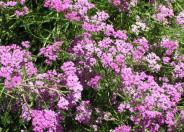
Common name:Rosea Yarrow
Botanical name:Achillea millefolium 'Rosea'
This perennial is a treat for those who like cut flowers to grace their table grows 18" to 24" tall, and 24" wide. It can tolerate poor, dry soil and full sun to part shade. The pretty pink flowers bloom in summer and sit on top of fern-like foliage. Yarrows propagate easily from rooted cuttings or divisions, which should be performed in the early spring or fall. Following bloom, one should dead head the plant and divide the clumps when it appears crowded.

Common name:Southern Sword Fern
Botanical name:Nephrolepis cordifolia
Nephrolepis cordifolia is tough and easy to grow. This fern has bright green, narrow, upright fronds in tufts to 2-3 ft. tall. Fronds have closely spaced, finely toothed leaflets.

Common name:Cedros Island Verbena
Botanical name:Verbena lilacina 'De La Mina'
Verbena lilacina 'De La Mina' is a selection introduced by the Santa Barbara Botanical Garden. It follows the same wonderful characteristics described under the general species V. lilacina.

Common name:Arctotis Daisy, African Daisy
Botanical name:Arctotis hybrids
African Daisy hybrids grow 12-18" high x 12" wide and produce daisy-like flowers from spring through summer. These hybrids have lobed leaves and bloom in whtie, pink, red, purple, cream and orange. For trailing African Daisies, see Osteospermum fruticosum, or 'Freeway Daisy'.
Healthy soil is the cornerstone of a vibrant landscape. It provides oxygen and nutrients vital to plant growth and sustenance. It provides protection from the sun and stability for root systems.
Click in the green box for more information

Common name:Yellow Monkey Flower
Botanical name:Mimulus Yellow
This Mimulus hybrid is characterized by its unusually large, yellow flowers that overpower every other feature of the plant. As with all other dry Mimulus species, it requires well drained soil with very infrequent summer water. In many gardens, it will
Designer: Nancy Niemeyer
Photographer: GardenSoft
Incorporate compost 6" into your soil to retain water, reduce compaction, feed earthworms, and provide valuable nutrients to your plants.
Be sure to fix all leaks promptly no matter how small they may seem.
Develop healthy soil for plants that are vigorous and naturally pest-resistant.